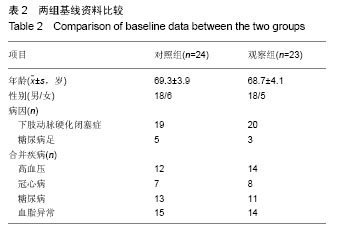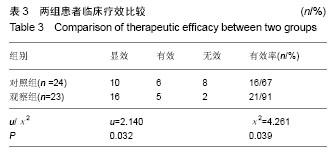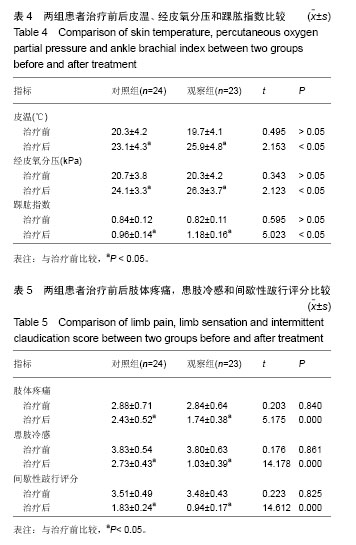中国组织工程研究 ›› 2017, Vol. 21 ›› Issue (1): 82-86.doi: 10.3969/j.issn.2095-4344.2017.01.015
• 干细胞移植 stem cell transplantation • 上一篇 下一篇
脐带间充质干细胞联合骨髓干细胞治疗下肢缺血
杜俊文,吴 韬,张 坤,苏白玉,卢彩萍,王伟超,雷 琳,郭静霞
- 石家庄市第一医院,河北省石家庄市 050000
Umbilical cord mesenchymal stem cells combined with bone marrow stem cells for treatment of lower limb ischemia
Du Jun-wen, Wu Tao, Zhang Kun, Su Bai-yu, Lu Cai-ping, Wang Wei-chao, Lei Lin, Guo Jing-xia
- First Hospital of Shijiazhuang, Shijiazhuang 050000, Hebei Province, China
摘要:
文章快速阅读:
.jpg)
文题释义: 联合治疗的理论基础:自身骨髓干细胞的分化、增殖能力显著降低,其黏附和参与血管形成的能力也均显著降低,机体不能为移植后的细胞提供理想的增殖分化环境等造成移植后分化形成血管的能力较弱,因此改善血供的作用也较差。脐带间充质干细胞分化能力强,移植后能够快速分化、增殖形成血管内皮细胞,进而形成血管,恢复下肢血供,改善临床症状。 踝肱指数:是血管外科最常用、最简单的一种检查方法,通过测量踝部胫后动脉或胫前动脉以及肱动脉的收缩压,得到踝部动脉压与肱动脉压之间的比值。
摘要 背景:骨髓干细胞移植治疗下肢缺血性疾病近年来在临床取得较大进步,但在实践过程中也发现由于老年患者骨髓干细胞数量较少,采集困难,分化能力降低,对临床疗效产生影响。 目的:探讨脐带间充质干细胞联合骨髓干细胞治疗下肢缺血的效果。 方法:选择2012年3月至2015年11月在石家庄市第一医院进行干细胞移植治疗的下肢缺血性病变患者47例,根据治疗方法不同分为观察组23例和对照组24例,对照组采用骨髓干细胞移植治疗,观察组采用脐带间充质干细胞联合骨髓干细胞移植治疗。 结果与结论:①观察组总有效率显著高于对照组(P=0.039);②观察组患者皮温、经皮氧分压和踝肱指数均显著高于对照组(P < 0.05);③观察组患者肢体疼痛、患肢冷感和间歇性跛行评分均显著低于对照组(P < 0.05);④由此可见脐带间充质干细胞联合骨髓干细胞治疗下肢缺血较单独采用骨髓干细胞能够更加有效提高患肢皮温、经皮氧分压和踝肱指数,改善患者疼痛及冷感等临床症状,疗效更佳。
中国组织工程研究杂志出版内容重点:干细胞;骨髓干细胞;造血干细胞;脂肪干细胞;肿瘤干细胞;胚胎干细胞;脐带脐血干细胞;干细胞诱导;干细胞分化;组织工程 ORCID: 0000-0001-8784-8132(杜俊文)
中图分类号:




.jpg)
.jpg)
.jpg)